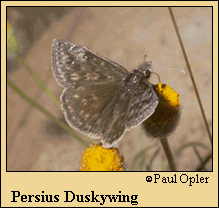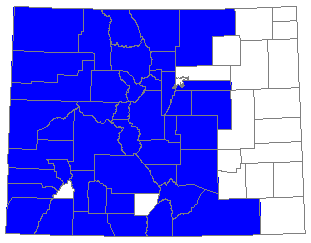 |
 

 |



Persius Duskywing (Erynnis persius [Scudder])
Wing span: 1 1/8 - 1 5/8 inches (2.9 - 4.2 cm).
Identification: Upperside is brown-black. Forewing has few clear dots and very dim markings; patch at end of cell is grayish. Male forewing has many raised white hairs. Hindwing fringes are dark. Male has a costal fold containing yellow scent scales; female has a patch of scent scales on the 7th abdominal segment.
Life history: During the day males perch on hilltops to seek females, usually sitting on the ground or on low twigs. Females lay eggs singly under leaves of the host plants. Caterpillars feed on leaves and live in shelters of rolled or tied leaves. Fully-grown caterpillars hibernate.
Flight: One brood from April-June.
Caterpillar hosts: Lupine (Lupinus), golden banner (Thermopsis), Lotus, and other legumes.
Adult food: Flower nectar.
Habitat: Open areas including mountain grasslands, marshes, sand plains, seeps, streamsides.
Range: In the west, from Alaska and the McKenzie River delta south to southeastern Manitoba; south through the western mountains to southern California, southern Arizona, and southeast New Mexico. In the east, northern New England west to Wisconsin; south in the Appalachians to Virginia.
Comments: The Columbine, Wild Indigo, and Persius dusky wings belong to the "Persius complex," a confusing group of very similar butterflies.
Conservation: Populations in the Midwest and Northeast found in pine-oak barrens should be monitored and conserved.
The Nature Conservancy Global Rank: G4 - Apparently secure globally, though it might be quite rare in parts of its range, especially at the periphery.
Management needs: Manage habitat of lupine-feeding populations by mechanical disturbance or infrequent burns (no more frequent than every 5 years).
References:
Opler, P. A. and G. O. Krizek. 1984. Butterflies east of the Great Plains. Johns
Hopkins University Press, Baltimore. 294 pages, 54 color plates.
Opler, P. A. and V. Malikul. 1992. A field guide to eastern butterflies. Peterson
field guide #4. Houghton-Mifflin Co., Boston. 396 pages, 48 color plates.
Scott, J. A. 1986. The butterflies of North America. Stanford University Press,
Stanford, Calif. 583 pages, 64 color plates.
Stanford, R. E. and P. A. Opler. 1993. Atlas of western USA butterflies including
adjacent parts of Canada and Mexico. Denver and Fort Collins, CO.
Tilden, J. W. 1986. A field guide to western butterflies. Houghton-Mifflin Co.,
Boston, Mass. 370 pages, 23 color plates.
Author: Jane M. Struttmann
State and Regional References:
Brown, F.M., Eff, J.D., and B. Rotger. 1957. Colorado Butterflies. Denver
Museum of Natural History, Denver.
Ferris, C.D. and F.M. Brown. 1980. Butterflies of the Rocky Mountain States.
University of Oklahoma Press. Norman.
Layberry, R.A., Hall, P.W. & Lafontaine, D.J., 1998. The Butterflies of
Canada. University of Toronto Press, Toronto, ON. 280 pp.
Opler, Paul A. 1999. Peterson Field Guide to Western Butterflies, revised
edition. Houghton Mifflin Co., Boston, Mass.
Stanford, R.E. and P.A. Opler. 1993. Atlas of Western USA Butterflies.
Privately published, Denver, Colo.
Tilden, J.W. and A.C. Smith. 1986. A Field Guide to Western Butterflies.
Houghton Mifflin Co., Boston, Mass.

